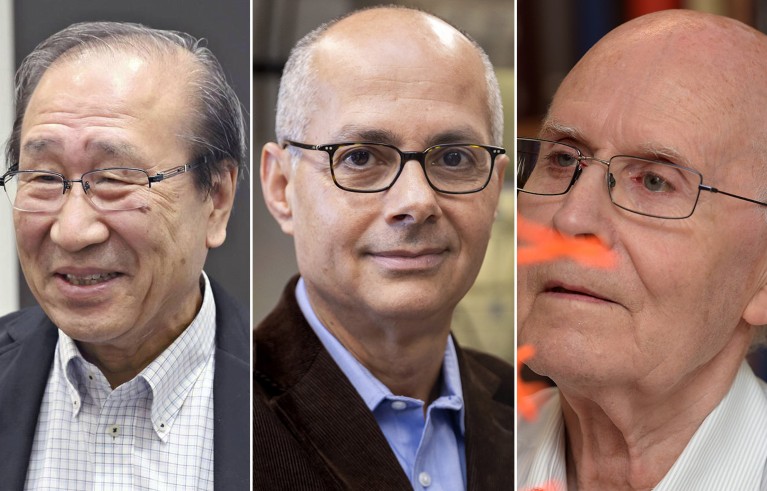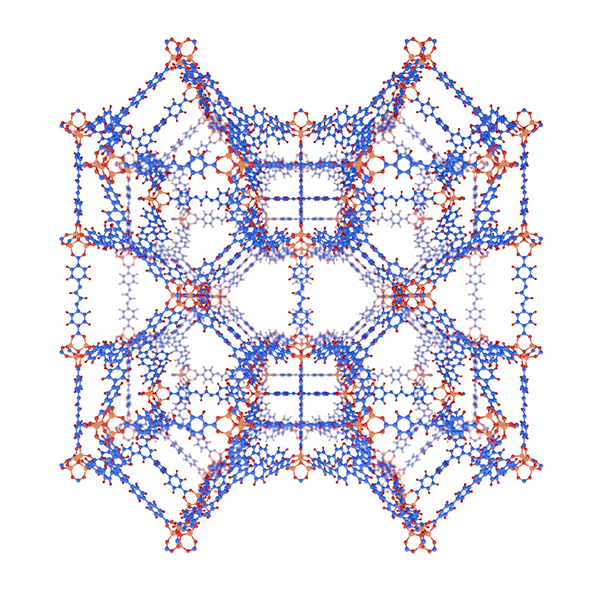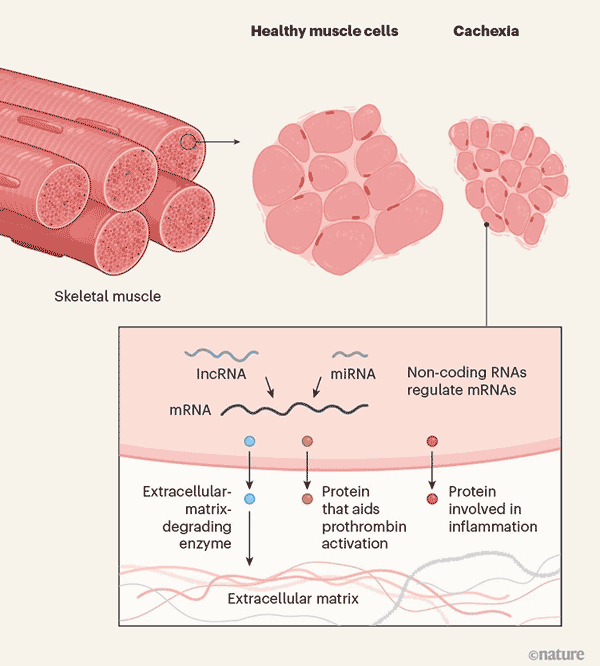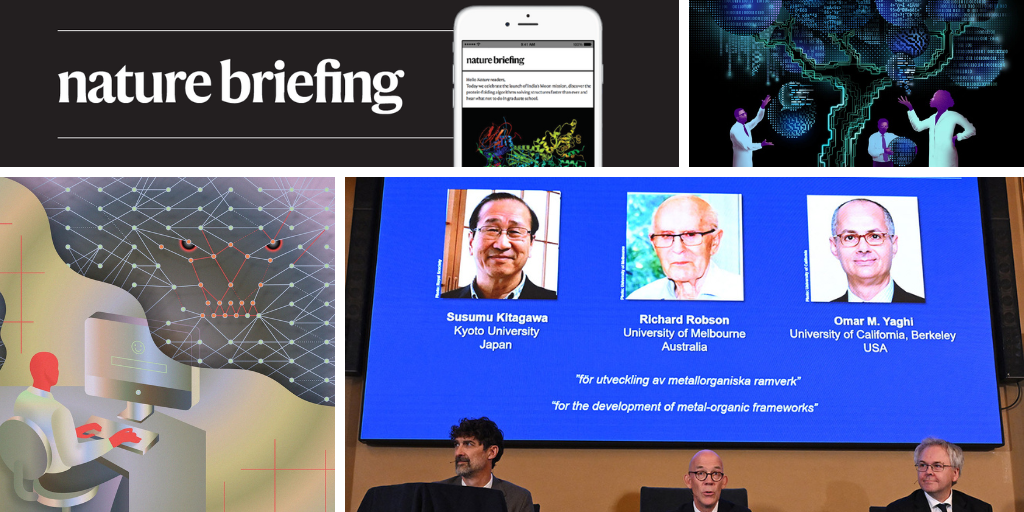You have full access to this article via your institution.
Hello Nature readers, would you like to get this Briefing in your inbox free every day? Sign up here.

Susumu Kitagawa, Omar Yaghi and Richard Robson have won the 2025 chemistry Nobel for the development of metal-organic frameworks.Credits: Kota Kawasaki/Yomiuri Shimbun via AP/Alamy, Brittany Hosea-Small/UC Berkeley, Paul Burston/University of Melbourne
Chemists Susumu Kitagawa, Richard Robson and Omar Yaghi have won the Nobel Prize in Chemistry for developing the world’s most porous solid materials, known as metal-organic frameworks (MOFs). Structured like molecular scaffolding, MOFs contain vast caverns of internal space; Nobel committee chair Heiner Linke likens them to “Hermione’s handbag in Harry Potter — it can store huge amounts of gas in a tiny volume”. In the 30 years since they were first developed, they have become part of efforts to capture carbon from the air and remove ‘forever chemicals’ from water, among many other applications.

This metal-organic framework, named DUT-60, holds the record for the material with the biggest internal surface area at a whopping 7,839 square metres per gram — plenty of room to trap and store gases. (Adapted from mofanatomy.com)
The material with the biggest internal surface area is a MOF named DUT-60, with an internal surface area of 7,839 square metres — around the size of a football field — per gram of material.
Read more in our feature on MOFs from July (10 min read) (Adapted from mofanatomy.com)
News
Male mice that exercise regularly can pass on their fitness to their male offspring. Researchers found that well-exercised male mice had higher levels of 10 types of microRNA in their sperm compared to mice that hadn’t exercised. These microRNAs influenced the metabolism and muscle function of an embryo during development, which resulted in male offspring that could run for longer on a treadmill than those who’d come from more sedentary fathers. A similar mechanism could be at play in humans — the team also found high levels of similar microRNAs in the sperm of men who exercise regularly.
Reference: Cell Metabolism paper
Most carbon offsets, which allow polluters to meet their emissions reductions targets by financing climate projects elsewhere, have “intractable” problems and are too easy to game, says a new review. “We have assessed 25 years of evidence and almost everything up until this point has failed,” says environmental governance and development researcher Stephen Lezak, who co-authored the review. Despite a few redeemable efforts, such as subsidizing cleaner cookstoves, the authors call for the phasing out of most carbon credits except those generated by permanent carbon dioxide removal.
Reference: Annual Review of Environment and Resources review
Features & opinion
Large language models (LLMs) don’t have intentions or understanding, but they can scheme and lie. For example, tests have shown that various popular models would engage in blackmail, corporate espionage, and even actions that could lead to death in highly contrived scenarios. In a separate test, a model that was told it had control over a robot attempted to disable its ethics module, make copies of itself, alter logs, act dumb, break out of the lab, and hack a car’s computer. Researchers suggest part of the cause might be the fact that LLMs are trained on so many computer-betrayal stories — think Hal from 2001: A Space Odyssey — and that papers describing LLM scheming could actually make the problem worse.
Reference: Anthropic report & COAI Research arXiv preprint
The code behind a study should be preserved and published to support its findings. But software — especially open source — is rarely static, and so it should also be available to build on and refine over time. To reconcile these two ideas, a group of 10 researchers and engineers outline recommendations on how software can be better handled, shared and maintained. Their suggestions include training all PhD students in code-sharing best practice, software archives hosted and supported by publishers and dedicated funding for the development and preservation of software.
Five former US surgeons general, who were appointed by every Republican and Democratic president since George H.W. Bush, have issued an unprecedented joint warning that “actions of Health and Human Services Secretary Robert F. Kennedy Jr are endangering the health of the nation”. “Science and expertise have taken a back seat to ideology and misinformation,” they write. “The consequences aren’t abstract. They are measured in lives lost, disease outbreaks and an erosion of public trust that will take years to rebuild.”
The Washington Post | 6 min read
Infographic of the week

Differences in RNA expression in muscle cells could explain why some people with cancer develop a wasting syndrome called cachexia and others don’t. Muscle cells of people with cachexia have reduced mass and size. Researchers found that the RNAs present in these cells boosted the production of inflammatory proteins, enzymes that degrade the cell’s surrounding matrix and the blood-clotting protein prothrombin. This activity was influenced by regulatory RNAs, such as microRNAs and long non-coding RNAs, that weren’t present in people who didn’t have cachexia. (Nature News & Views | 7 min read)
As autumn draws in for those of us in the Northern Hemisphere, all thoughts turn to giant pumpkins (do they not?) Should you wish to nurture a giant gourd yourself, start with brushing up on the science of growing super-sized squashes and then listen to physicist David Hu explain how a pumpkin can get so big without breaking.
Help me to cultivate a perfectly formed newsletter by fertilizing it with your feedback at [email protected].
Thanks for reading,
Flora Graham, senior editor, Nature Briefing
With contributions by Jacob Smith
• Nature Briefing: Careers — insights, advice and award-winning journalism to help you optimize your working life
• Nature Briefing: Microbiology — the most abundant living entities on our planet — microorganisms — and the role they play in health, the environment and food systems
• Nature Briefing: Anthropocene — climate change, biodiversity, sustainability and geoengineering
• Nature Briefing: AI & Robotics — 100% written by humans, of course
• Nature Briefing: Cancer — a weekly newsletter written with cancer researchers in mind
• Nature Briefing: Translational Research — covers biotechnology, drug discovery and pharma


